Risk Management Plan: Construction of a 10-Storey Commercial Building
VerifiedAdded on 2020/10/22
|19
|5083
|55
Report
AI Summary
This report presents a comprehensive Risk Management Plan developed for a construction project undertaken by Lendlease, an Australian engineering organization. Focused on the construction of a 10-story commercial building, the plan addresses crucial aspects of risk management. The report begins with an executive summary, followed by an introduction that emphasizes the importance of risk management in ensuring project safety and quality. It details the project scope, objectives, and boundaries, including a breakdown of the budget and a Gantt chart. The core of the plan outlines consultation and communication strategies, including verbal and written methods such as video conferencing, meetings, emails, and risk identification reports. It then identifies key stakeholders like top management, the project manager, and the project team, detailing their roles and responsibilities. The report further describes the risk assessment process, including identification, analysis, evaluation, treatment, and communication of risks, using frameworks like FMECA and Tolerability of Risk (TOR). Finally, it emphasizes the importance of monitoring and review processes to ensure the plan's effectiveness. The report's structure and content provide a practical guide to managing and mitigating risks in construction projects.
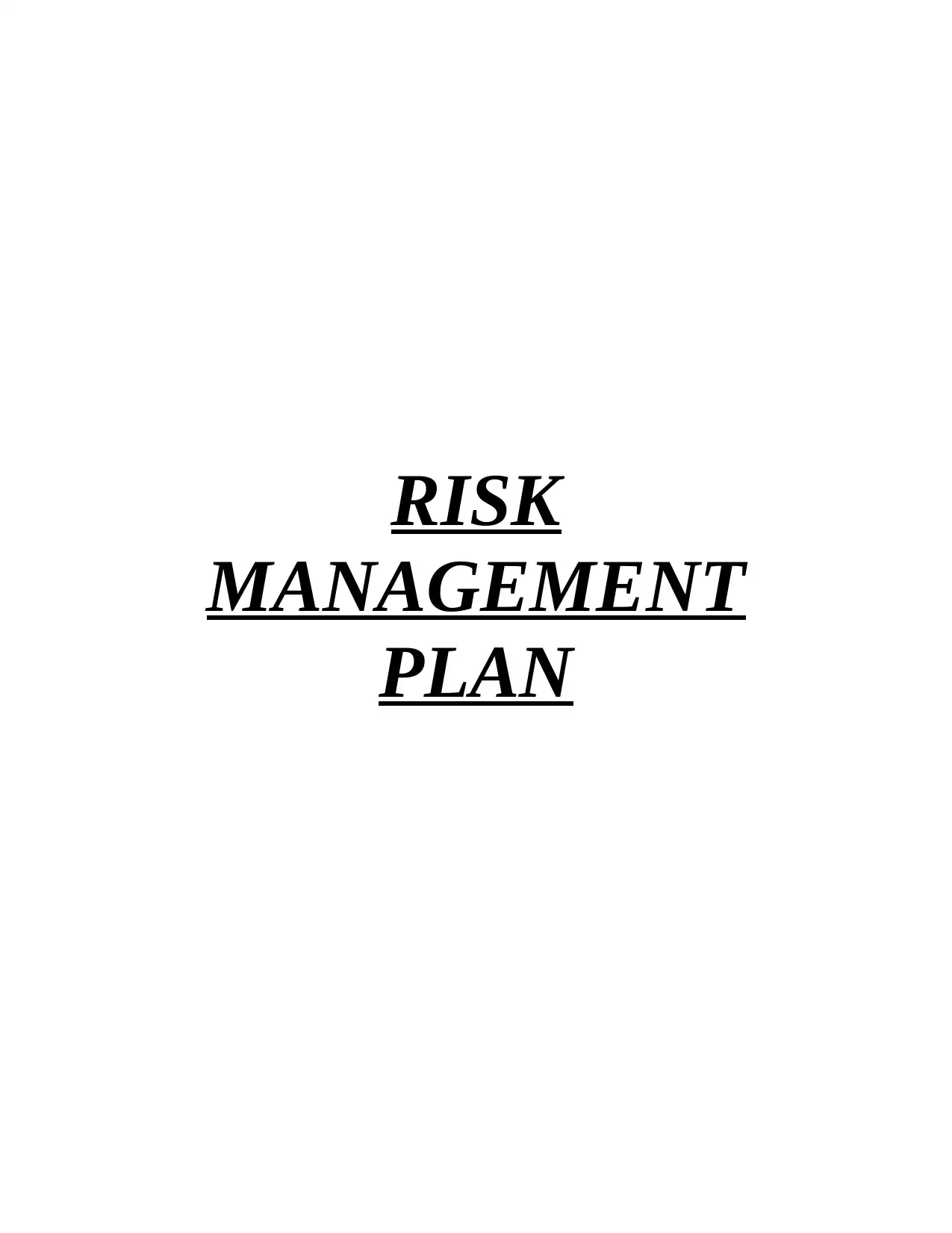
RISK
MANAGEMENT
PLAN
MANAGEMENT
PLAN
Paraphrase This Document
Need a fresh take? Get an instant paraphrase of this document with our AI Paraphraser
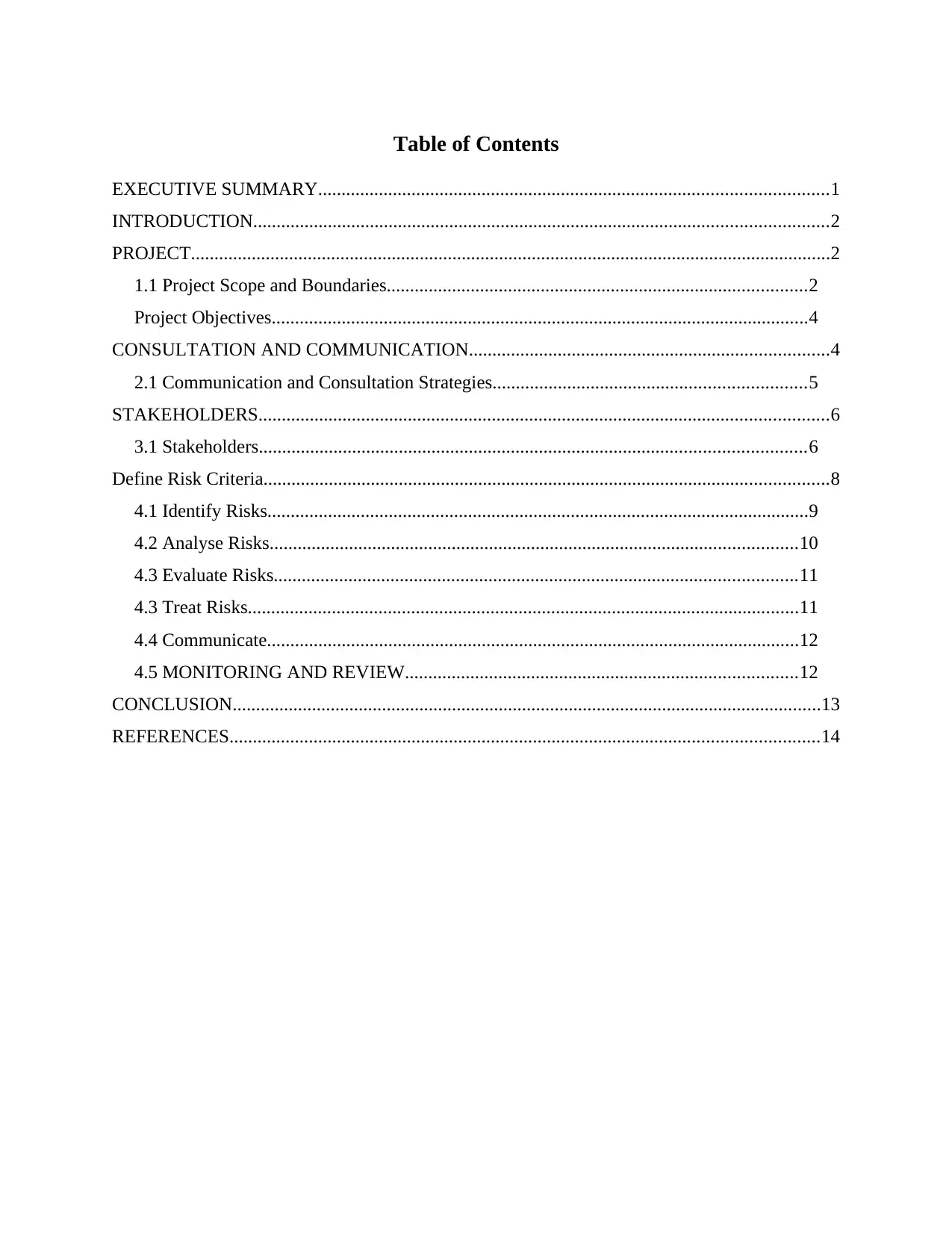
Table of Contents
EXECUTIVE SUMMARY.............................................................................................................1
INTRODUCTION...........................................................................................................................2
PROJECT.........................................................................................................................................2
1.1 Project Scope and Boundaries..........................................................................................2
Project Objectives...................................................................................................................4
CONSULTATION AND COMMUNICATION.............................................................................4
2.1 Communication and Consultation Strategies...................................................................5
STAKEHOLDERS..........................................................................................................................6
3.1 Stakeholders.....................................................................................................................6
Define Risk Criteria.........................................................................................................................8
4.1 Identify Risks....................................................................................................................9
4.2 Analyse Risks.................................................................................................................10
4.3 Evaluate Risks................................................................................................................11
4.3 Treat Risks......................................................................................................................11
4.4 Communicate..................................................................................................................12
4.5 MONITORING AND REVIEW....................................................................................12
CONCLUSION..............................................................................................................................13
REFERENCES..............................................................................................................................14
EXECUTIVE SUMMARY.............................................................................................................1
INTRODUCTION...........................................................................................................................2
PROJECT.........................................................................................................................................2
1.1 Project Scope and Boundaries..........................................................................................2
Project Objectives...................................................................................................................4
CONSULTATION AND COMMUNICATION.............................................................................4
2.1 Communication and Consultation Strategies...................................................................5
STAKEHOLDERS..........................................................................................................................6
3.1 Stakeholders.....................................................................................................................6
Define Risk Criteria.........................................................................................................................8
4.1 Identify Risks....................................................................................................................9
4.2 Analyse Risks.................................................................................................................10
4.3 Evaluate Risks................................................................................................................11
4.3 Treat Risks......................................................................................................................11
4.4 Communicate..................................................................................................................12
4.5 MONITORING AND REVIEW....................................................................................12
CONCLUSION..............................................................................................................................13
REFERENCES..............................................................................................................................14

⊘ This is a preview!⊘
Do you want full access?
Subscribe today to unlock all pages.

Trusted by 1+ million students worldwide
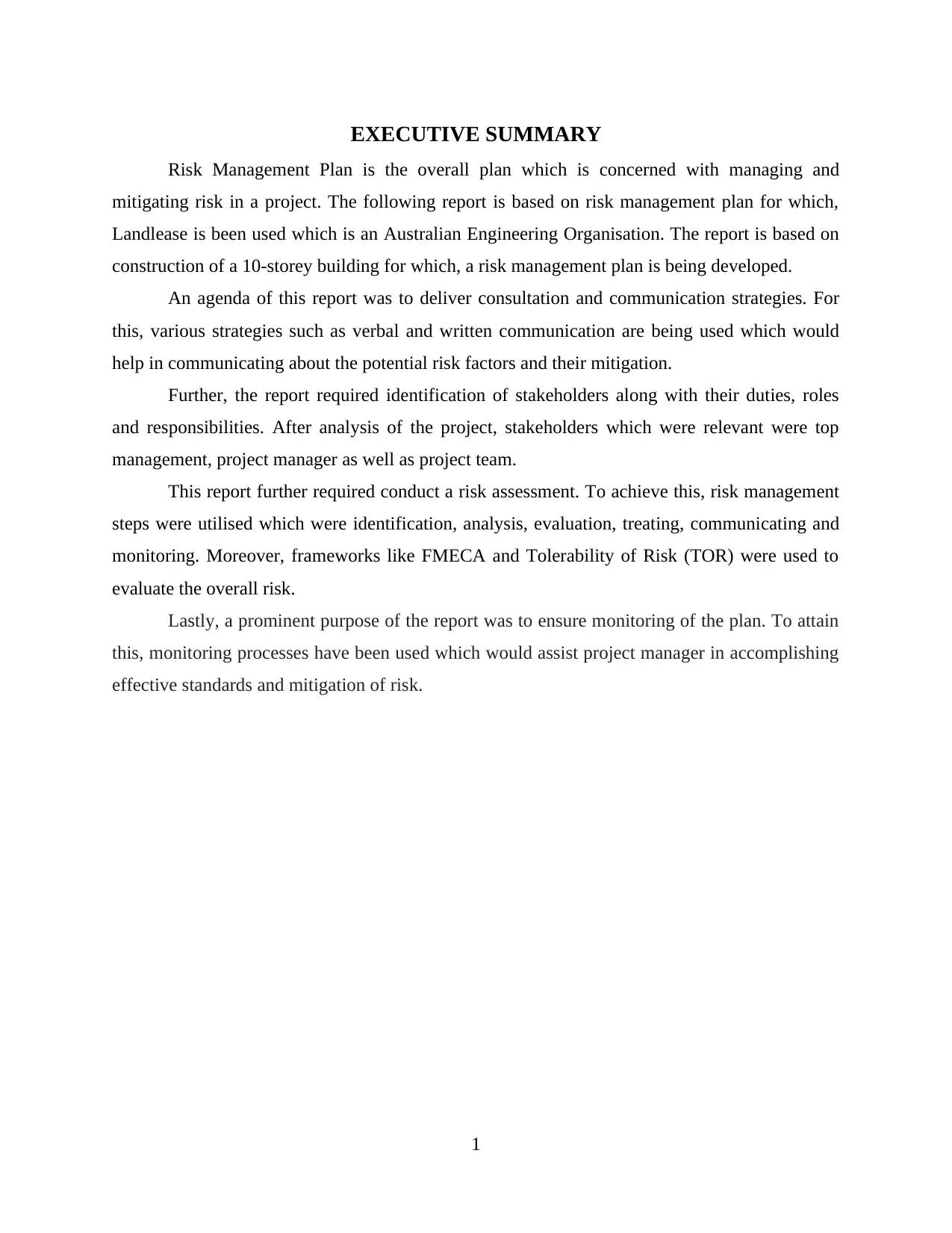
EXECUTIVE SUMMARY
Risk Management Plan is the overall plan which is concerned with managing and
mitigating risk in a project. The following report is based on risk management plan for which,
Landlease is been used which is an Australian Engineering Organisation. The report is based on
construction of a 10-storey building for which, a risk management plan is being developed.
An agenda of this report was to deliver consultation and communication strategies. For
this, various strategies such as verbal and written communication are being used which would
help in communicating about the potential risk factors and their mitigation.
Further, the report required identification of stakeholders along with their duties, roles
and responsibilities. After analysis of the project, stakeholders which were relevant were top
management, project manager as well as project team.
This report further required conduct a risk assessment. To achieve this, risk management
steps were utilised which were identification, analysis, evaluation, treating, communicating and
monitoring. Moreover, frameworks like FMECA and Tolerability of Risk (TOR) were used to
evaluate the overall risk.
Lastly, a prominent purpose of the report was to ensure monitoring of the plan. To attain
this, monitoring processes have been used which would assist project manager in accomplishing
effective standards and mitigation of risk.
1
Risk Management Plan is the overall plan which is concerned with managing and
mitigating risk in a project. The following report is based on risk management plan for which,
Landlease is been used which is an Australian Engineering Organisation. The report is based on
construction of a 10-storey building for which, a risk management plan is being developed.
An agenda of this report was to deliver consultation and communication strategies. For
this, various strategies such as verbal and written communication are being used which would
help in communicating about the potential risk factors and their mitigation.
Further, the report required identification of stakeholders along with their duties, roles
and responsibilities. After analysis of the project, stakeholders which were relevant were top
management, project manager as well as project team.
This report further required conduct a risk assessment. To achieve this, risk management
steps were utilised which were identification, analysis, evaluation, treating, communicating and
monitoring. Moreover, frameworks like FMECA and Tolerability of Risk (TOR) were used to
evaluate the overall risk.
Lastly, a prominent purpose of the report was to ensure monitoring of the plan. To attain
this, monitoring processes have been used which would assist project manager in accomplishing
effective standards and mitigation of risk.
1
Paraphrase This Document
Need a fresh take? Get an instant paraphrase of this document with our AI Paraphraser
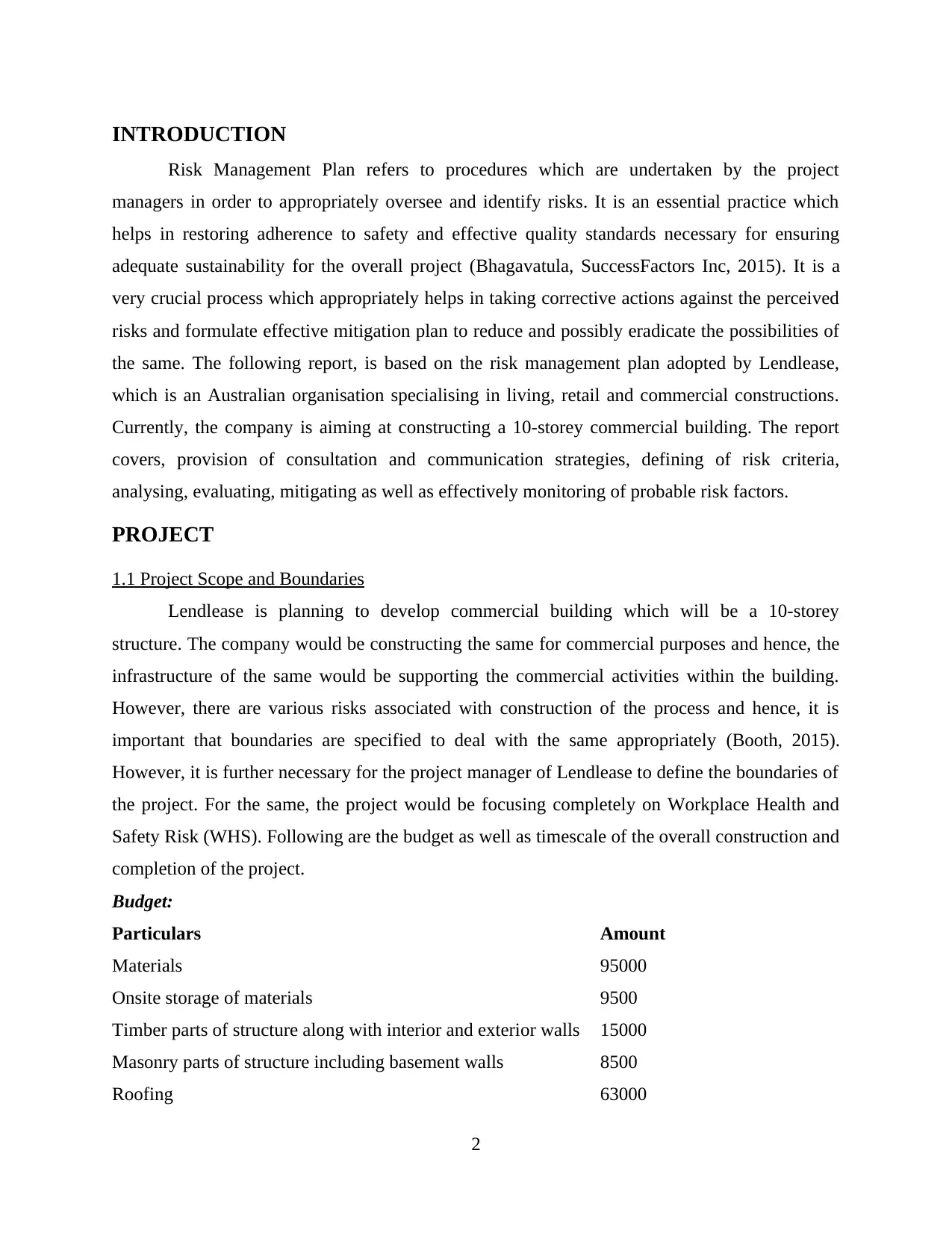
INTRODUCTION
Risk Management Plan refers to procedures which are undertaken by the project
managers in order to appropriately oversee and identify risks. It is an essential practice which
helps in restoring adherence to safety and effective quality standards necessary for ensuring
adequate sustainability for the overall project (Bhagavatula, SuccessFactors Inc, 2015). It is a
very crucial process which appropriately helps in taking corrective actions against the perceived
risks and formulate effective mitigation plan to reduce and possibly eradicate the possibilities of
the same. The following report, is based on the risk management plan adopted by Lendlease,
which is an Australian organisation specialising in living, retail and commercial constructions.
Currently, the company is aiming at constructing a 10-storey commercial building. The report
covers, provision of consultation and communication strategies, defining of risk criteria,
analysing, evaluating, mitigating as well as effectively monitoring of probable risk factors.
PROJECT
1.1 Project Scope and Boundaries
Lendlease is planning to develop commercial building which will be a 10-storey
structure. The company would be constructing the same for commercial purposes and hence, the
infrastructure of the same would be supporting the commercial activities within the building.
However, there are various risks associated with construction of the process and hence, it is
important that boundaries are specified to deal with the same appropriately (Booth, 2015).
However, it is further necessary for the project manager of Lendlease to define the boundaries of
the project. For the same, the project would be focusing completely on Workplace Health and
Safety Risk (WHS). Following are the budget as well as timescale of the overall construction and
completion of the project.
Budget:
Particulars Amount
Materials 95000
Onsite storage of materials 9500
Timber parts of structure along with interior and exterior walls 15000
Masonry parts of structure including basement walls 8500
Roofing 63000
2
Risk Management Plan refers to procedures which are undertaken by the project
managers in order to appropriately oversee and identify risks. It is an essential practice which
helps in restoring adherence to safety and effective quality standards necessary for ensuring
adequate sustainability for the overall project (Bhagavatula, SuccessFactors Inc, 2015). It is a
very crucial process which appropriately helps in taking corrective actions against the perceived
risks and formulate effective mitigation plan to reduce and possibly eradicate the possibilities of
the same. The following report, is based on the risk management plan adopted by Lendlease,
which is an Australian organisation specialising in living, retail and commercial constructions.
Currently, the company is aiming at constructing a 10-storey commercial building. The report
covers, provision of consultation and communication strategies, defining of risk criteria,
analysing, evaluating, mitigating as well as effectively monitoring of probable risk factors.
PROJECT
1.1 Project Scope and Boundaries
Lendlease is planning to develop commercial building which will be a 10-storey
structure. The company would be constructing the same for commercial purposes and hence, the
infrastructure of the same would be supporting the commercial activities within the building.
However, there are various risks associated with construction of the process and hence, it is
important that boundaries are specified to deal with the same appropriately (Booth, 2015).
However, it is further necessary for the project manager of Lendlease to define the boundaries of
the project. For the same, the project would be focusing completely on Workplace Health and
Safety Risk (WHS). Following are the budget as well as timescale of the overall construction and
completion of the project.
Budget:
Particulars Amount
Materials 95000
Onsite storage of materials 9500
Timber parts of structure along with interior and exterior walls 15000
Masonry parts of structure including basement walls 8500
Roofing 63000
2
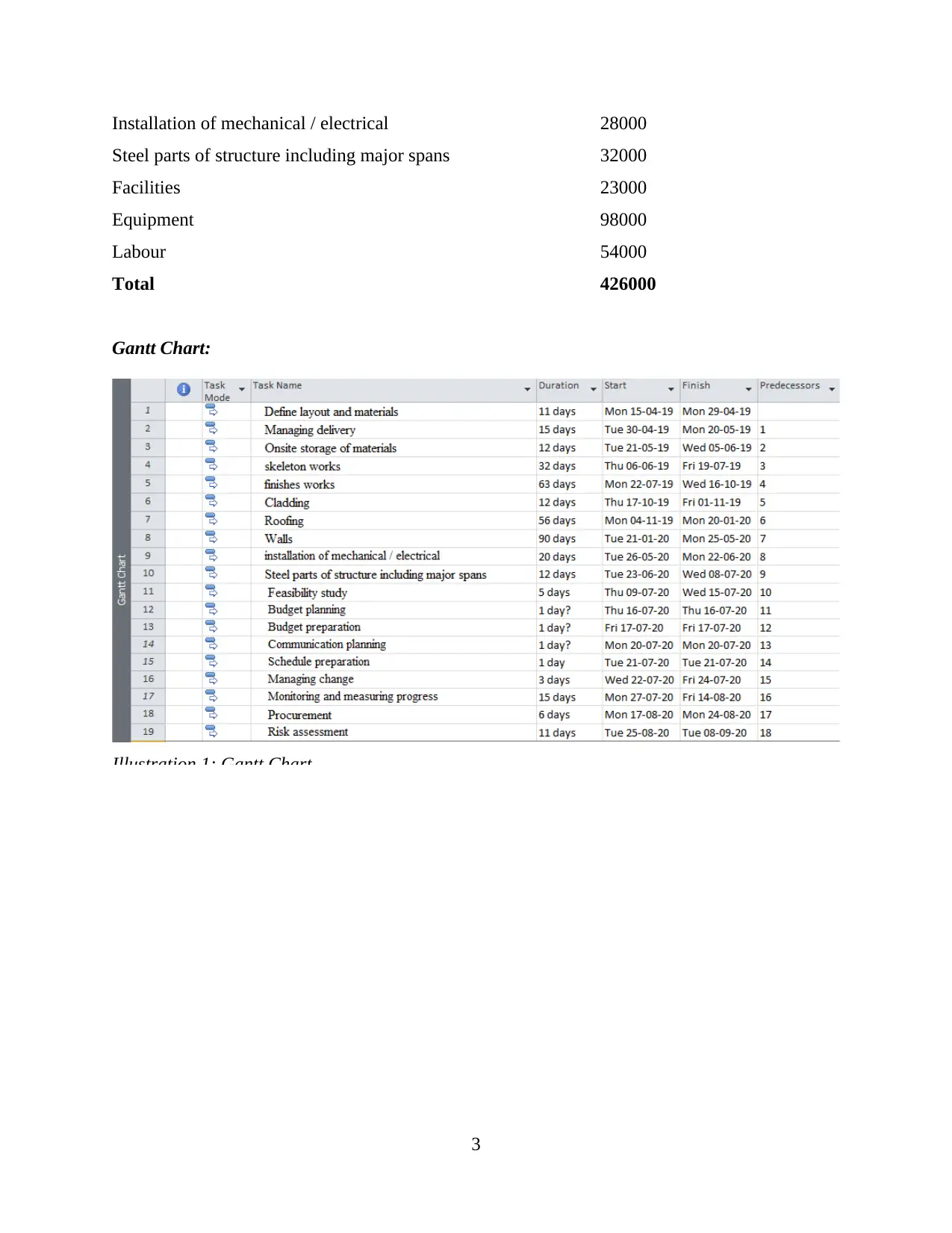
Installation of mechanical / electrical 28000
Steel parts of structure including major spans 32000
Facilities 23000
Equipment 98000
Labour 54000
Total 426000
Gantt Chart:
Illustration 1: Gantt Chart
3
Steel parts of structure including major spans 32000
Facilities 23000
Equipment 98000
Labour 54000
Total 426000
Gantt Chart:
Illustration 1: Gantt Chart
3
⊘ This is a preview!⊘
Do you want full access?
Subscribe today to unlock all pages.

Trusted by 1+ million students worldwide
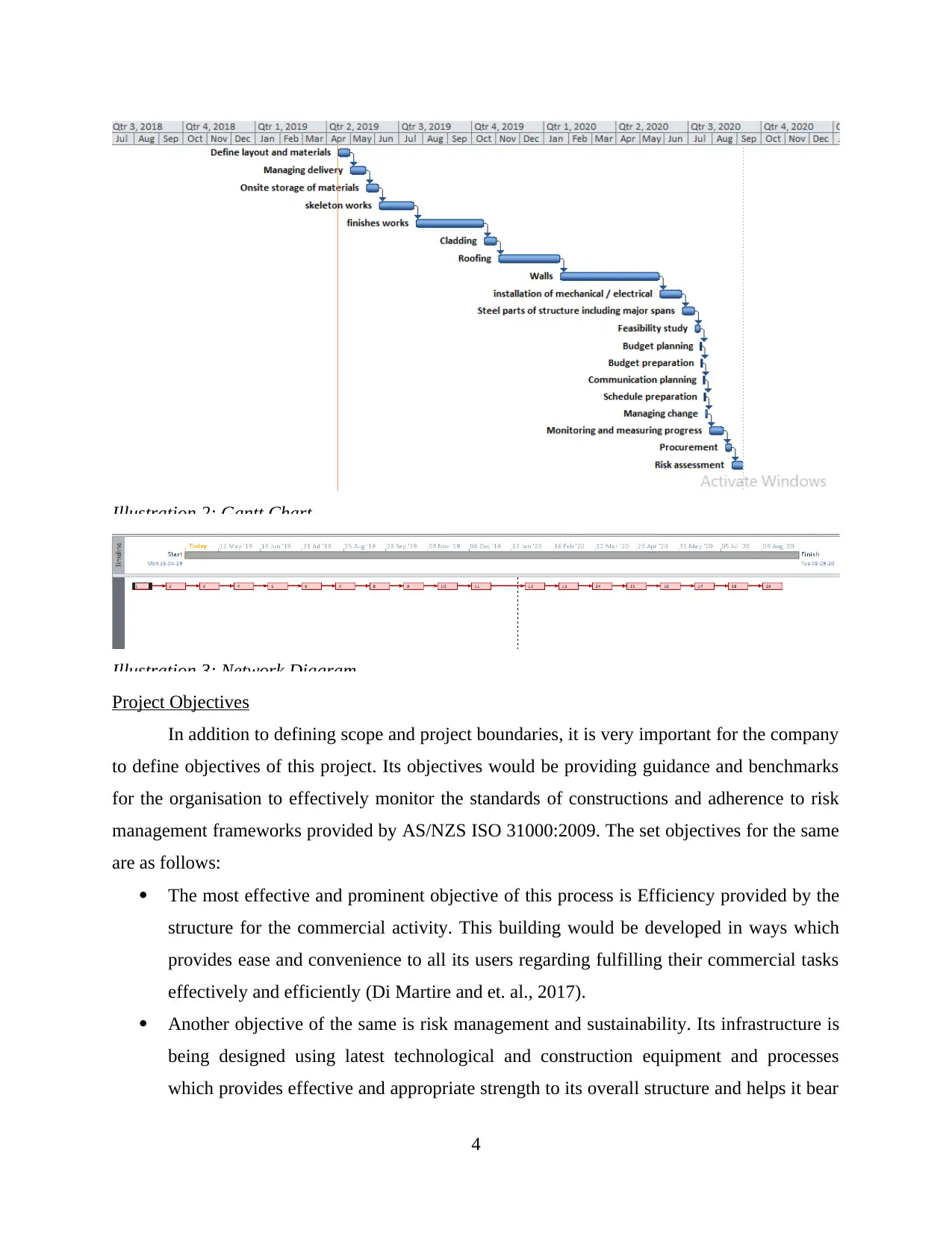
Illustration 2: Gantt Chart
Illustration 3: Network Diagram
Project Objectives
In addition to defining scope and project boundaries, it is very important for the company
to define objectives of this project. Its objectives would be providing guidance and benchmarks
for the organisation to effectively monitor the standards of constructions and adherence to risk
management frameworks provided by AS/NZS ISO 31000:2009. The set objectives for the same
are as follows:
The most effective and prominent objective of this process is Efficiency provided by the
structure for the commercial activity. This building would be developed in ways which
provides ease and convenience to all its users regarding fulfilling their commercial tasks
effectively and efficiently (Di Martire and et. al., 2017).
Another objective of the same is risk management and sustainability. Its infrastructure is
being designed using latest technological and construction equipment and processes
which provides effective and appropriate strength to its overall structure and helps it bear
4
Illustration 3: Network Diagram
Project Objectives
In addition to defining scope and project boundaries, it is very important for the company
to define objectives of this project. Its objectives would be providing guidance and benchmarks
for the organisation to effectively monitor the standards of constructions and adherence to risk
management frameworks provided by AS/NZS ISO 31000:2009. The set objectives for the same
are as follows:
The most effective and prominent objective of this process is Efficiency provided by the
structure for the commercial activity. This building would be developed in ways which
provides ease and convenience to all its users regarding fulfilling their commercial tasks
effectively and efficiently (Di Martire and et. al., 2017).
Another objective of the same is risk management and sustainability. Its infrastructure is
being designed using latest technological and construction equipment and processes
which provides effective and appropriate strength to its overall structure and helps it bear
4
Paraphrase This Document
Need a fresh take? Get an instant paraphrase of this document with our AI Paraphraser
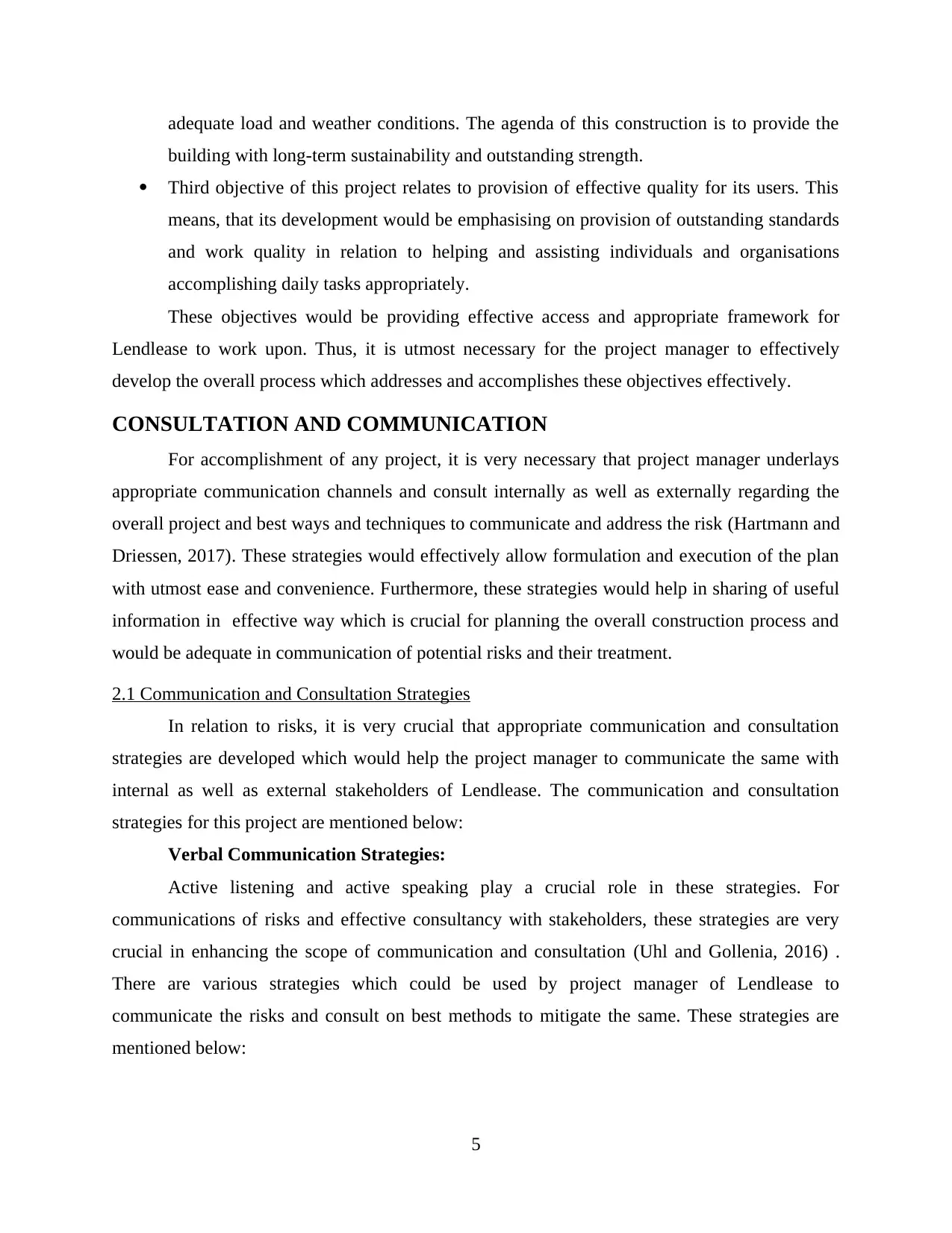
adequate load and weather conditions. The agenda of this construction is to provide the
building with long-term sustainability and outstanding strength.
Third objective of this project relates to provision of effective quality for its users. This
means, that its development would be emphasising on provision of outstanding standards
and work quality in relation to helping and assisting individuals and organisations
accomplishing daily tasks appropriately.
These objectives would be providing effective access and appropriate framework for
Lendlease to work upon. Thus, it is utmost necessary for the project manager to effectively
develop the overall process which addresses and accomplishes these objectives effectively.
CONSULTATION AND COMMUNICATION
For accomplishment of any project, it is very necessary that project manager underlays
appropriate communication channels and consult internally as well as externally regarding the
overall project and best ways and techniques to communicate and address the risk (Hartmann and
Driessen, 2017). These strategies would effectively allow formulation and execution of the plan
with utmost ease and convenience. Furthermore, these strategies would help in sharing of useful
information in effective way which is crucial for planning the overall construction process and
would be adequate in communication of potential risks and their treatment.
2.1 Communication and Consultation Strategies
In relation to risks, it is very crucial that appropriate communication and consultation
strategies are developed which would help the project manager to communicate the same with
internal as well as external stakeholders of Lendlease. The communication and consultation
strategies for this project are mentioned below:
Verbal Communication Strategies:
Active listening and active speaking play a crucial role in these strategies. For
communications of risks and effective consultancy with stakeholders, these strategies are very
crucial in enhancing the scope of communication and consultation (Uhl and Gollenia, 2016) .
There are various strategies which could be used by project manager of Lendlease to
communicate the risks and consult on best methods to mitigate the same. These strategies are
mentioned below:
5
building with long-term sustainability and outstanding strength.
Third objective of this project relates to provision of effective quality for its users. This
means, that its development would be emphasising on provision of outstanding standards
and work quality in relation to helping and assisting individuals and organisations
accomplishing daily tasks appropriately.
These objectives would be providing effective access and appropriate framework for
Lendlease to work upon. Thus, it is utmost necessary for the project manager to effectively
develop the overall process which addresses and accomplishes these objectives effectively.
CONSULTATION AND COMMUNICATION
For accomplishment of any project, it is very necessary that project manager underlays
appropriate communication channels and consult internally as well as externally regarding the
overall project and best ways and techniques to communicate and address the risk (Hartmann and
Driessen, 2017). These strategies would effectively allow formulation and execution of the plan
with utmost ease and convenience. Furthermore, these strategies would help in sharing of useful
information in effective way which is crucial for planning the overall construction process and
would be adequate in communication of potential risks and their treatment.
2.1 Communication and Consultation Strategies
In relation to risks, it is very crucial that appropriate communication and consultation
strategies are developed which would help the project manager to communicate the same with
internal as well as external stakeholders of Lendlease. The communication and consultation
strategies for this project are mentioned below:
Verbal Communication Strategies:
Active listening and active speaking play a crucial role in these strategies. For
communications of risks and effective consultancy with stakeholders, these strategies are very
crucial in enhancing the scope of communication and consultation (Uhl and Gollenia, 2016) .
There are various strategies which could be used by project manager of Lendlease to
communicate the risks and consult on best methods to mitigate the same. These strategies are
mentioned below:
5
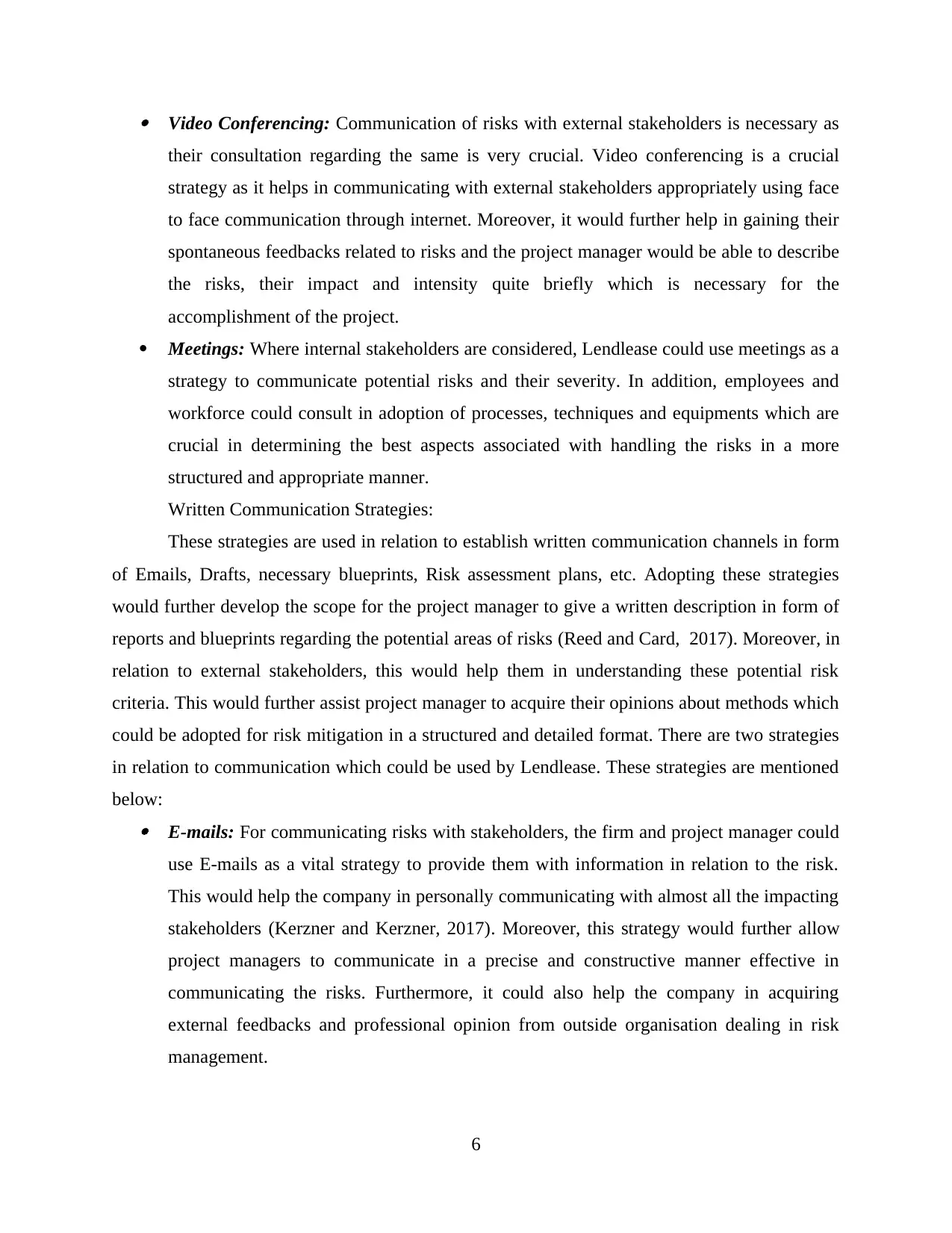
Video Conferencing: Communication of risks with external stakeholders is necessary as
their consultation regarding the same is very crucial. Video conferencing is a crucial
strategy as it helps in communicating with external stakeholders appropriately using face
to face communication through internet. Moreover, it would further help in gaining their
spontaneous feedbacks related to risks and the project manager would be able to describe
the risks, their impact and intensity quite briefly which is necessary for the
accomplishment of the project.
Meetings: Where internal stakeholders are considered, Lendlease could use meetings as a
strategy to communicate potential risks and their severity. In addition, employees and
workforce could consult in adoption of processes, techniques and equipments which are
crucial in determining the best aspects associated with handling the risks in a more
structured and appropriate manner.
Written Communication Strategies:
These strategies are used in relation to establish written communication channels in form
of Emails, Drafts, necessary blueprints, Risk assessment plans, etc. Adopting these strategies
would further develop the scope for the project manager to give a written description in form of
reports and blueprints regarding the potential areas of risks (Reed and Card, 2017). Moreover, in
relation to external stakeholders, this would help them in understanding these potential risk
criteria. This would further assist project manager to acquire their opinions about methods which
could be adopted for risk mitigation in a structured and detailed format. There are two strategies
in relation to communication which could be used by Lendlease. These strategies are mentioned
below: E-mails: For communicating risks with stakeholders, the firm and project manager could
use E-mails as a vital strategy to provide them with information in relation to the risk.
This would help the company in personally communicating with almost all the impacting
stakeholders (Kerzner and Kerzner, 2017). Moreover, this strategy would further allow
project managers to communicate in a precise and constructive manner effective in
communicating the risks. Furthermore, it could also help the company in acquiring
external feedbacks and professional opinion from outside organisation dealing in risk
management.
6
their consultation regarding the same is very crucial. Video conferencing is a crucial
strategy as it helps in communicating with external stakeholders appropriately using face
to face communication through internet. Moreover, it would further help in gaining their
spontaneous feedbacks related to risks and the project manager would be able to describe
the risks, their impact and intensity quite briefly which is necessary for the
accomplishment of the project.
Meetings: Where internal stakeholders are considered, Lendlease could use meetings as a
strategy to communicate potential risks and their severity. In addition, employees and
workforce could consult in adoption of processes, techniques and equipments which are
crucial in determining the best aspects associated with handling the risks in a more
structured and appropriate manner.
Written Communication Strategies:
These strategies are used in relation to establish written communication channels in form
of Emails, Drafts, necessary blueprints, Risk assessment plans, etc. Adopting these strategies
would further develop the scope for the project manager to give a written description in form of
reports and blueprints regarding the potential areas of risks (Reed and Card, 2017). Moreover, in
relation to external stakeholders, this would help them in understanding these potential risk
criteria. This would further assist project manager to acquire their opinions about methods which
could be adopted for risk mitigation in a structured and detailed format. There are two strategies
in relation to communication which could be used by Lendlease. These strategies are mentioned
below: E-mails: For communicating risks with stakeholders, the firm and project manager could
use E-mails as a vital strategy to provide them with information in relation to the risk.
This would help the company in personally communicating with almost all the impacting
stakeholders (Kerzner and Kerzner, 2017). Moreover, this strategy would further allow
project managers to communicate in a precise and constructive manner effective in
communicating the risks. Furthermore, it could also help the company in acquiring
external feedbacks and professional opinion from outside organisation dealing in risk
management.
6
⊘ This is a preview!⊘
Do you want full access?
Subscribe today to unlock all pages.

Trusted by 1+ million students worldwide
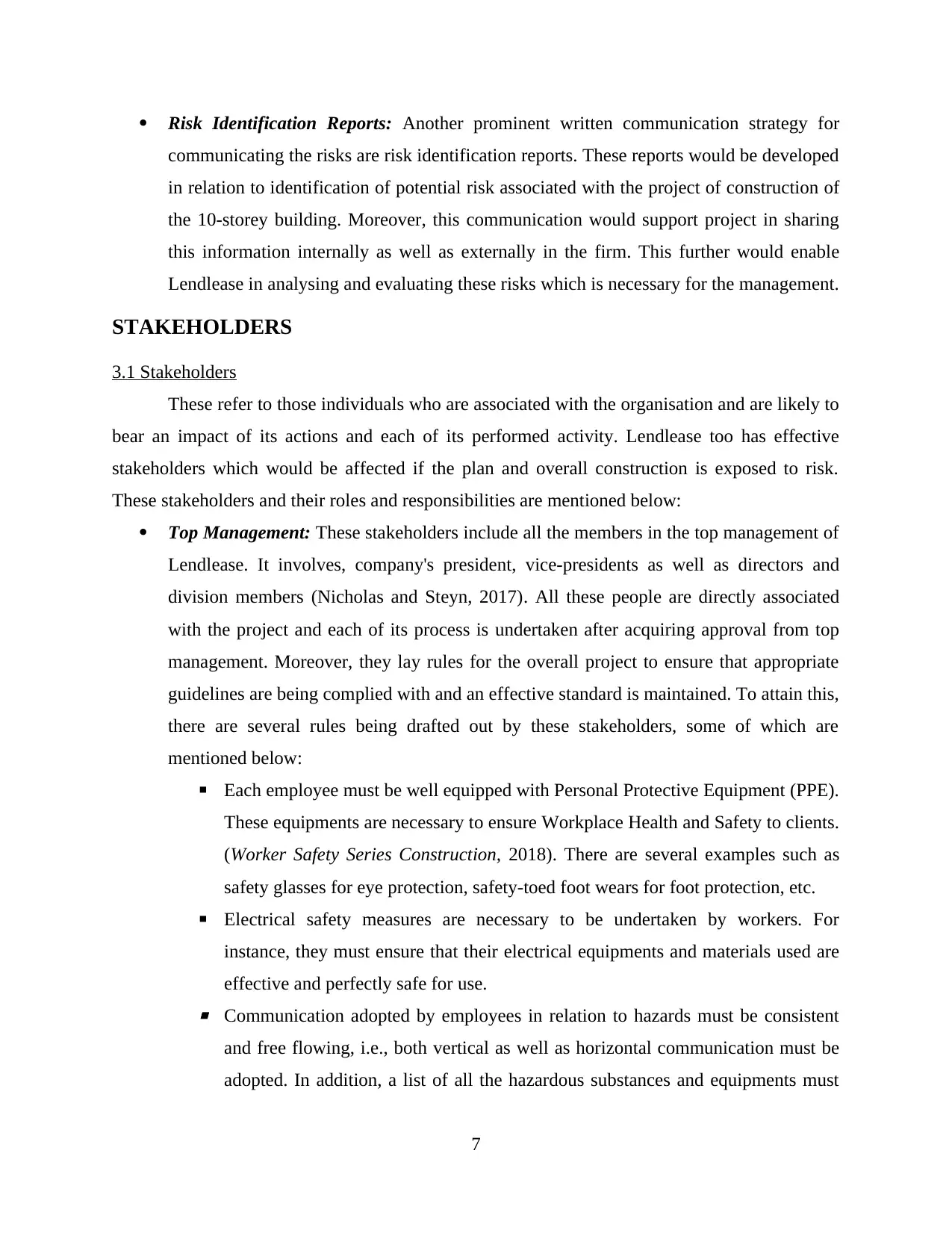
Risk Identification Reports: Another prominent written communication strategy for
communicating the risks are risk identification reports. These reports would be developed
in relation to identification of potential risk associated with the project of construction of
the 10-storey building. Moreover, this communication would support project in sharing
this information internally as well as externally in the firm. This further would enable
Lendlease in analysing and evaluating these risks which is necessary for the management.
STAKEHOLDERS
3.1 Stakeholders
These refer to those individuals who are associated with the organisation and are likely to
bear an impact of its actions and each of its performed activity. Lendlease too has effective
stakeholders which would be affected if the plan and overall construction is exposed to risk.
These stakeholders and their roles and responsibilities are mentioned below:
Top Management: These stakeholders include all the members in the top management of
Lendlease. It involves, company's president, vice-presidents as well as directors and
division members (Nicholas and Steyn, 2017). All these people are directly associated
with the project and each of its process is undertaken after acquiring approval from top
management. Moreover, they lay rules for the overall project to ensure that appropriate
guidelines are being complied with and an effective standard is maintained. To attain this,
there are several rules being drafted out by these stakeholders, some of which are
mentioned below:
▪ Each employee must be well equipped with Personal Protective Equipment (PPE).
These equipments are necessary to ensure Workplace Health and Safety to clients.
(Worker Safety Series Construction, 2018). There are several examples such as
safety glasses for eye protection, safety-toed foot wears for foot protection, etc.
▪ Electrical safety measures are necessary to be undertaken by workers. For
instance, they must ensure that their electrical equipments and materials used are
effective and perfectly safe for use.
▪ Communication adopted by employees in relation to hazards must be consistent
and free flowing, i.e., both vertical as well as horizontal communication must be
adopted. In addition, a list of all the hazardous substances and equipments must
7
communicating the risks are risk identification reports. These reports would be developed
in relation to identification of potential risk associated with the project of construction of
the 10-storey building. Moreover, this communication would support project in sharing
this information internally as well as externally in the firm. This further would enable
Lendlease in analysing and evaluating these risks which is necessary for the management.
STAKEHOLDERS
3.1 Stakeholders
These refer to those individuals who are associated with the organisation and are likely to
bear an impact of its actions and each of its performed activity. Lendlease too has effective
stakeholders which would be affected if the plan and overall construction is exposed to risk.
These stakeholders and their roles and responsibilities are mentioned below:
Top Management: These stakeholders include all the members in the top management of
Lendlease. It involves, company's president, vice-presidents as well as directors and
division members (Nicholas and Steyn, 2017). All these people are directly associated
with the project and each of its process is undertaken after acquiring approval from top
management. Moreover, they lay rules for the overall project to ensure that appropriate
guidelines are being complied with and an effective standard is maintained. To attain this,
there are several rules being drafted out by these stakeholders, some of which are
mentioned below:
▪ Each employee must be well equipped with Personal Protective Equipment (PPE).
These equipments are necessary to ensure Workplace Health and Safety to clients.
(Worker Safety Series Construction, 2018). There are several examples such as
safety glasses for eye protection, safety-toed foot wears for foot protection, etc.
▪ Electrical safety measures are necessary to be undertaken by workers. For
instance, they must ensure that their electrical equipments and materials used are
effective and perfectly safe for use.
▪ Communication adopted by employees in relation to hazards must be consistent
and free flowing, i.e., both vertical as well as horizontal communication must be
adopted. In addition, a list of all the hazardous substances and equipments must
7
Paraphrase This Document
Need a fresh take? Get an instant paraphrase of this document with our AI Paraphraser
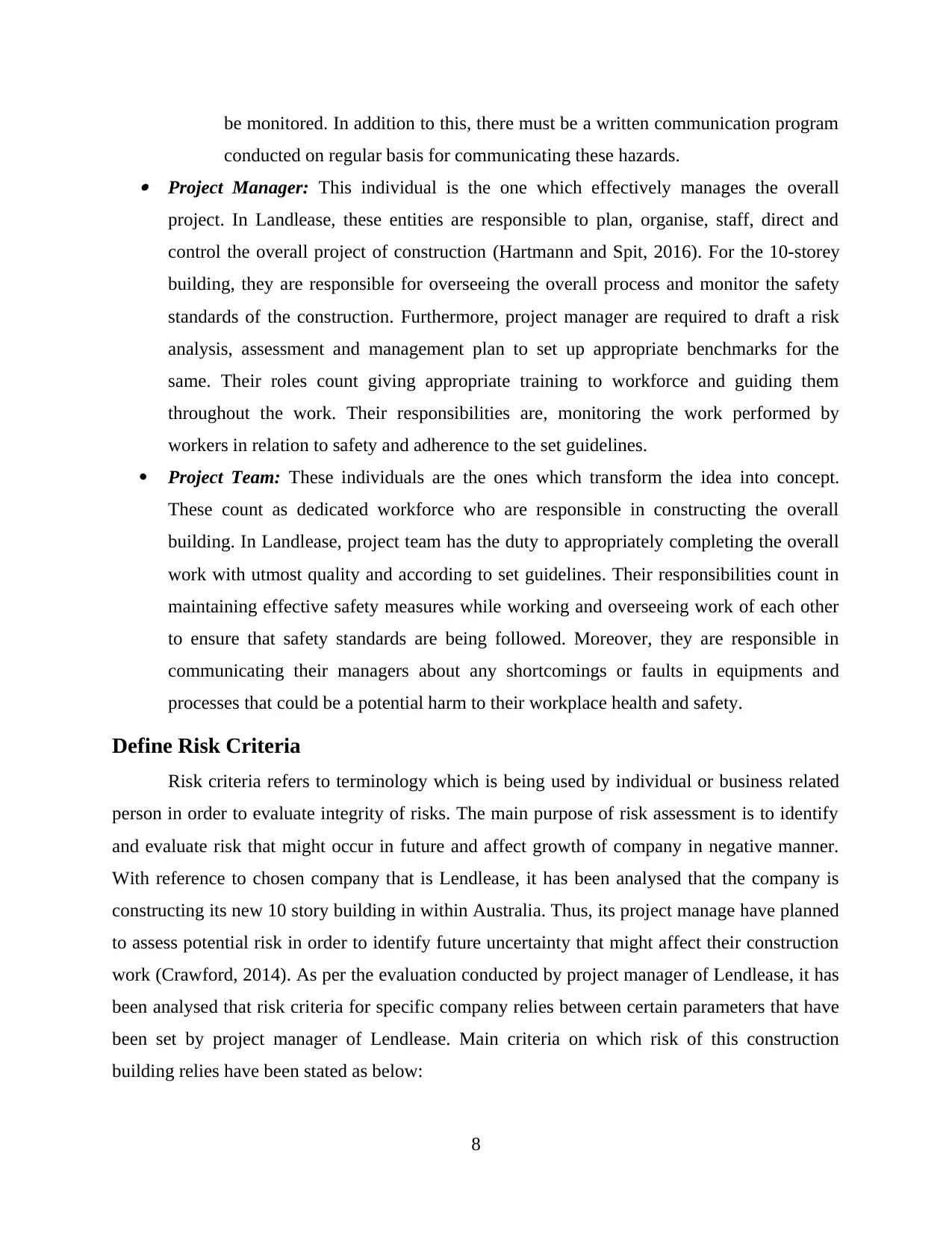
be monitored. In addition to this, there must be a written communication program
conducted on regular basis for communicating these hazards. Project Manager: This individual is the one which effectively manages the overall
project. In Landlease, these entities are responsible to plan, organise, staff, direct and
control the overall project of construction (Hartmann and Spit, 2016). For the 10-storey
building, they are responsible for overseeing the overall process and monitor the safety
standards of the construction. Furthermore, project manager are required to draft a risk
analysis, assessment and management plan to set up appropriate benchmarks for the
same. Their roles count giving appropriate training to workforce and guiding them
throughout the work. Their responsibilities are, monitoring the work performed by
workers in relation to safety and adherence to the set guidelines.
Project Team: These individuals are the ones which transform the idea into concept.
These count as dedicated workforce who are responsible in constructing the overall
building. In Landlease, project team has the duty to appropriately completing the overall
work with utmost quality and according to set guidelines. Their responsibilities count in
maintaining effective safety measures while working and overseeing work of each other
to ensure that safety standards are being followed. Moreover, they are responsible in
communicating their managers about any shortcomings or faults in equipments and
processes that could be a potential harm to their workplace health and safety.
Define Risk Criteria
Risk criteria refers to terminology which is being used by individual or business related
person in order to evaluate integrity of risks. The main purpose of risk assessment is to identify
and evaluate risk that might occur in future and affect growth of company in negative manner.
With reference to chosen company that is Lendlease, it has been analysed that the company is
constructing its new 10 story building in within Australia. Thus, its project manage have planned
to assess potential risk in order to identify future uncertainty that might affect their construction
work (Crawford, 2014). As per the evaluation conducted by project manager of Lendlease, it has
been analysed that risk criteria for specific company relies between certain parameters that have
been set by project manager of Lendlease. Main criteria on which risk of this construction
building relies have been stated as below:
8
conducted on regular basis for communicating these hazards. Project Manager: This individual is the one which effectively manages the overall
project. In Landlease, these entities are responsible to plan, organise, staff, direct and
control the overall project of construction (Hartmann and Spit, 2016). For the 10-storey
building, they are responsible for overseeing the overall process and monitor the safety
standards of the construction. Furthermore, project manager are required to draft a risk
analysis, assessment and management plan to set up appropriate benchmarks for the
same. Their roles count giving appropriate training to workforce and guiding them
throughout the work. Their responsibilities are, monitoring the work performed by
workers in relation to safety and adherence to the set guidelines.
Project Team: These individuals are the ones which transform the idea into concept.
These count as dedicated workforce who are responsible in constructing the overall
building. In Landlease, project team has the duty to appropriately completing the overall
work with utmost quality and according to set guidelines. Their responsibilities count in
maintaining effective safety measures while working and overseeing work of each other
to ensure that safety standards are being followed. Moreover, they are responsible in
communicating their managers about any shortcomings or faults in equipments and
processes that could be a potential harm to their workplace health and safety.
Define Risk Criteria
Risk criteria refers to terminology which is being used by individual or business related
person in order to evaluate integrity of risks. The main purpose of risk assessment is to identify
and evaluate risk that might occur in future and affect growth of company in negative manner.
With reference to chosen company that is Lendlease, it has been analysed that the company is
constructing its new 10 story building in within Australia. Thus, its project manage have planned
to assess potential risk in order to identify future uncertainty that might affect their construction
work (Crawford, 2014). As per the evaluation conducted by project manager of Lendlease, it has
been analysed that risk criteria for specific company relies between certain parameters that have
been set by project manager of Lendlease. Main criteria on which risk of this construction
building relies have been stated as below:
8
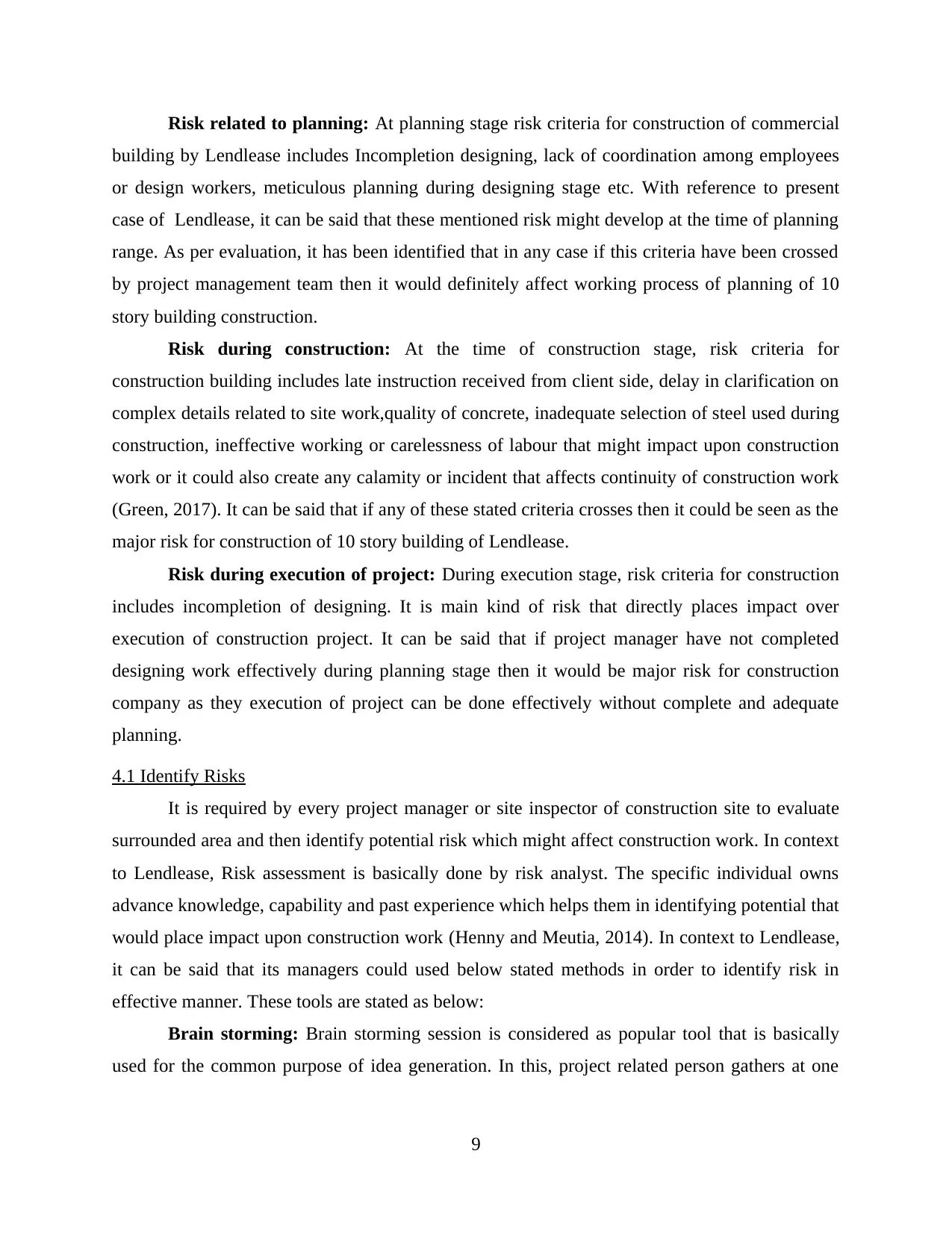
Risk related to planning: At planning stage risk criteria for construction of commercial
building by Lendlease includes Incompletion designing, lack of coordination among employees
or design workers, meticulous planning during designing stage etc. With reference to present
case of Lendlease, it can be said that these mentioned risk might develop at the time of planning
range. As per evaluation, it has been identified that in any case if this criteria have been crossed
by project management team then it would definitely affect working process of planning of 10
story building construction.
Risk during construction: At the time of construction stage, risk criteria for
construction building includes late instruction received from client side, delay in clarification on
complex details related to site work,quality of concrete, inadequate selection of steel used during
construction, ineffective working or carelessness of labour that might impact upon construction
work or it could also create any calamity or incident that affects continuity of construction work
(Green, 2017). It can be said that if any of these stated criteria crosses then it could be seen as the
major risk for construction of 10 story building of Lendlease.
Risk during execution of project: During execution stage, risk criteria for construction
includes incompletion of designing. It is main kind of risk that directly places impact over
execution of construction project. It can be said that if project manager have not completed
designing work effectively during planning stage then it would be major risk for construction
company as they execution of project can be done effectively without complete and adequate
planning.
4.1 Identify Risks
It is required by every project manager or site inspector of construction site to evaluate
surrounded area and then identify potential risk which might affect construction work. In context
to Lendlease, Risk assessment is basically done by risk analyst. The specific individual owns
advance knowledge, capability and past experience which helps them in identifying potential that
would place impact upon construction work (Henny and Meutia, 2014). In context to Lendlease,
it can be said that its managers could used below stated methods in order to identify risk in
effective manner. These tools are stated as below:
Brain storming: Brain storming session is considered as popular tool that is basically
used for the common purpose of idea generation. In this, project related person gathers at one
9
building by Lendlease includes Incompletion designing, lack of coordination among employees
or design workers, meticulous planning during designing stage etc. With reference to present
case of Lendlease, it can be said that these mentioned risk might develop at the time of planning
range. As per evaluation, it has been identified that in any case if this criteria have been crossed
by project management team then it would definitely affect working process of planning of 10
story building construction.
Risk during construction: At the time of construction stage, risk criteria for
construction building includes late instruction received from client side, delay in clarification on
complex details related to site work,quality of concrete, inadequate selection of steel used during
construction, ineffective working or carelessness of labour that might impact upon construction
work or it could also create any calamity or incident that affects continuity of construction work
(Green, 2017). It can be said that if any of these stated criteria crosses then it could be seen as the
major risk for construction of 10 story building of Lendlease.
Risk during execution of project: During execution stage, risk criteria for construction
includes incompletion of designing. It is main kind of risk that directly places impact over
execution of construction project. It can be said that if project manager have not completed
designing work effectively during planning stage then it would be major risk for construction
company as they execution of project can be done effectively without complete and adequate
planning.
4.1 Identify Risks
It is required by every project manager or site inspector of construction site to evaluate
surrounded area and then identify potential risk which might affect construction work. In context
to Lendlease, Risk assessment is basically done by risk analyst. The specific individual owns
advance knowledge, capability and past experience which helps them in identifying potential that
would place impact upon construction work (Henny and Meutia, 2014). In context to Lendlease,
it can be said that its managers could used below stated methods in order to identify risk in
effective manner. These tools are stated as below:
Brain storming: Brain storming session is considered as popular tool that is basically
used for the common purpose of idea generation. In this, project related person gathers at one
9
⊘ This is a preview!⊘
Do you want full access?
Subscribe today to unlock all pages.

Trusted by 1+ million students worldwide
1 out of 19
Related Documents
Your All-in-One AI-Powered Toolkit for Academic Success.
+13062052269
info@desklib.com
Available 24*7 on WhatsApp / Email
![[object Object]](/_next/static/media/star-bottom.7253800d.svg)
Unlock your academic potential
Copyright © 2020–2025 A2Z Services. All Rights Reserved. Developed and managed by ZUCOL.





